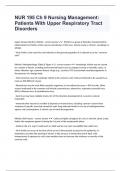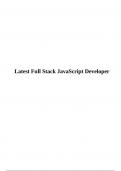NUR 195 Ch 9 Nursing Management:
Patients With Upper Respiratory Tract
Disorders
Upper Airway Infection: Rhinitis - correct answer ✔✔- Rhinitis is a group of disorders characterized by
inflammation & irritation of the mucous membranes of the nose. May be acute or chronic, nonallergic or
allergic.
- Viral rhinitis is the most freq viral infection in the general population & is referred to as the "common
cold."
Rhinitis: Pathophysiology (Table & Figure 9-1) - correct answer ✔✔- Nonallergic rhinitis may be caused
by a variety of factors, including environmental factors such as changes in temp or humidity, odors, or
foods; infection; age; systemic disease; drugs (e.g., cocaine), OTC & prescribed nasal decongestants; &
the presence of a foreign body.
- Most common cause of nonallergic rhinitis is the common cold. Colds are believed to be caused by as
many as 200 different viruses.
- Rhinoviruses are the most likely causative organisms, & are believed to cause > 40% of colds. Other
viruses implicated in the common cold include coronaviruses, adenovirus, respiratory syncytial virus
(RSV), influenza virus, & parainfluenza virus.
- Each virus may have multiple strains. B/c of this diversity, development of a vaccine is almost
impossible.
- Immunity after recovery is variable & depends on many factors, including a person's natural host
resistance & specific virus that caused the cold. Drug-induced rhinitis is a/w use of antihypertensive
agents, oral contraceptives, & chronic use of nasal decongestants.
Rhinitis: Risk Factors - correct answer ✔✔- Colds are highly contagious b/c virus is shed for about 2 days
before the symptoms appear & during the 1st part of the symptomatic phase.
- Adults in the U.S. avg 2-3 colds each yr. Adult women are more susceptible than adult men.
- Viral rhinitis can occur at any time of the yr, but 3 time periods account for the epidemics: in
September, just after the opening of school; in late January; & toward the end of April. Cold
temperatures & exposure to cold, rainy weather does not increase the incidence or severity of the
common cold.
,Rhinitis: Clinical Manifestations and Assessment - correct answer ✔✔- S/s of nonallergic rhinitis include
rhinorrhea (excessive nasal drainage, runny nose); nasal congestion; nasal discharge (purulent w/
bacterial rhinitis); sneezing; & pruritus of the nose, roof of the mouth, throat, eyes, & ears. HA may
occur, particularly if sinusitis is also present. Symptoms may last from 1-2 wks.
- Additional symptoms: sore throat, general malaise, low-grade fever, chills, & muscle aches. As illness
progresses, cough usually appears. In some ppl, the virus exacerbates herpes simplex, commonly called a
"cold sore."
Rhinitis: Medical and Nursing Management - correct answer ✔✔- Management consists of symptomatic
therapy. Med therapy for allergic & nonallergic rhinitis focuses on symptom relief.
- Choice of meds depends on symptoms, adverse reactions, adherence factors, risk of drug interactions,
& cost to the pt.
- Acetaminophen or NSAIDs, such as aspirin or ibuprofen, relieve the aches, pains, & fever.
- 4 major categories of meds used to manage cold symptoms are antihistamines, decongestants,
antitussives, & expectorants.
- Antihistamines remain the most common treatment & are administered for sneezing, nasal congestion,
pruritus, & rhinorrhea. Most common adverse effects of antihistamines are sedation, dry mouth, & GI
upset & cardiac arrhythmias. Antihistamines have been show to aggravate certain conditions & should
be used w/ caution in pts w asthma, urinary retention, htn, open-angle glaucoma, & prostatic
hypertrophy.
- Topical nasal decongestants should be used w/ caution. Topical therapy delivers med directly to the
nasal mucosa, but overuse can produce rhinitis medicamentosa (increase in severity or duration of
rhinitis) or rebound rhinitis.
- Oral decongestant agents may be used for congestive nasal obstruction. Use of saline nasal spray can
act as a mild decongestant & can liquefy mucus to prevent crusting. Expectorants are available w/o a
prescription & are used to promote removal of secretions.
- Several antiviral meds are available by prescription. Antimicrobial agents (antibiotics) should not be
used, b/c they do not affect the virus or reduce the incidence of bacterial complications, & they have
been implicated in development of organisms resistant to therapy.
- Herbal meds (e.g., echinacea, zinc lozenges, zinc nasal spray) are freq used to treat the common cold;
however, evidence regarding their effectiveness in shortening the symptomatic phase is questionable.
- Inhal
Upper Airway Infection: Rhinosinusitis - correct answer ✔✔- Rhinosinusitis is an inflammatory process
involving the paranasal sinuses & nasal cavity.
, - Rhinosinusitis affects 1 in 7 Americans, about 31 million ppl in the U.S., & accounts for billions of dollars
in direct health care costs.
- Uncomplicated rhinosinusitis does not extend beyond the paranasal sinuses & nasal cavity.
- Rhinosinusitis is classified by duration of symptoms as acute (< 4 wks), subacute (4-12 wks), & chronic
(>12 wks) w/ or w/o acute exacerbations.
- Rhinosinusitis can be further classified as an acute bacterial rhinosinusitis (ABRS) or acute viral
rhinosinusitis (AVRS).
- Recurrent acute rhinosinusitis is characterized by 4 or more acute episodes of ABRS per yr w/o
symptoms of rhinosinusitis b/w episodes.
- Chronic rhinosinusitis (CRS) affects 14%-16% of the U.S. population. Occurs more often in women than
men & accounts for almost 20 million office visits annually. In about 29%-36% of pts, CRS is accompanied
by nasal polyps.
Rhinosinusitis: Pathophysiology (Figure 9-1) - correct answer ✔✔- Acute rhinosinusitis usually follows a
viral URI or cold, such as an unresolved viral or bacterial infection, or an exacerbation of allergic rhinitis.
- Nasal congestion, caused by inflammation, edema, & transudation of fluid secondary to URI, leads to
obstruction of the sinus cavities. This provides an excellent medium for bacterial growth.
- CRS occurs w/ episodes of prolonged inflammation & w/ repeated or inadequate treatment of acute
infections. Irreversible damage to the mucosa may occur, & symptoms last for > 3 months.
- Bacterial organisms account for >60% of the cases of acute rhinosinusitis. Streptococcus pneumoniae,
Haemophilus influenzae, & less commonly Staphylococcus aureus & Moraxella catarrhalis are implicated.
Other organisms that are occasionally isolated include Chlamydia pneumoniae, Streptococcus pyogenes,
viruses, & fungi (Aspergillus fumigatus). Immunodeficiency should be considered in pts w/ CRS or acute
recurrent rhinosinusitis. Acute fulminant/invasive sinusitis is a life-threatening illness & is commonly
attributed to Aspergillus.
Rhinosinusitis: Risk Factors - correct answer ✔✔- Some ppl are more prone to rhinosinusitis b/c
exposure to environmental hazards such as paint, sawdust, & chemicals may result in chronic
inflammation of the nasal passages.
- If sinus drainage is obstructed by a deviated septum or by hypertrophied turbinates, spurs, or nasal
polyps or tumors, sinus infection may persist as a persistent secondary infection or progress to an acute
suppurative process (causing purulent discharge).
- Other conditions that can block the normal flow of sinus secretions include abnormal structures of the
nose, enlarged adenoids, diving & swimming, tooth infection, trauma to the nose, tumors, & the
pressure of foreign objects.





